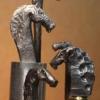
Damastang
Members-
Posts
49 -
Joined
-
Last visited
-
show me your destroyed anvil!
Damastang replied to joshua.M's topic in Repairing and Modification to Anvils
Lol "An-a-vil cruelty" -
(Spits on ground) "Welcome to Australia"
-
Ok this one takes the cake, ill stop now. you can have this for a bargain starting bid of $800!!!!! looks to be an 84 pound Wilkinson from the other pictures. That's $9.53/pound! What a steal!
-
-
How about this, absolute bargain, $2200 for the anvil plus a few pairs of tongs, top tools and branding irons worth about $150-$200. Say the anvil on its own is worth $2000 to the seller, that's $8.92/pound!!!!! and BK anvils are by no means rare in Australia.
-
Lol what a joke, sadly EVERY anvil here in AU is priced that way. There doesn't seem to be a shortage of anvils, i've seen heaps, they are just about everywhere on farms, workshops .ect people are just asking WAY too much or would rather store their pot plants on them or keep them just to say "i have an anvil" because they are made of gold.
-
That's a mighty fine anvil mate, awesome stuff. Can't imagine there would be many other HB anvils here in Australia. Be good to catch up again, Hans is planning another hammer in at his workshop next weekend I think, will see you there.
-
Cheers frosty, I may be going a bit overboard with the borax . I leave my mating surfaces at a grinding wheel (angle grinder) finish with the grind lines running across the width of the billet. I would have thought the rough grind lines would help the billet to weld? When you say flux cold, what do you use? Sounds like a good idea.
-
Easiest way to test for leaks is with compressed air and soapy water. Fill the tank with air and spray soapy water on your welds with a spray bottle. Any holes will bubble and carry on and will very easily be spotted. DO NOT however overfill the tank as it will explode! It doesn't take much. When I did mine I had the air gun in the return port with a rag around it and a rag in the suction port so the air was able to escape and not build up too much pressure.
-
G'day Finally have my press up and running, it worked out better than I could have imagined. One thing that I am having trouble getting my head around though is setting welds in the press. Without the quick sharp blows of the hammer to blast it all out, wouldn't the flux and other crap be caught between the layers and prevent a weld? I made up a quick billet yesturday and tried setting the initial weld under the flatter die on my press. The heat and everything was correct and I gave it a light squeeze then straight back in the fire then a heavier squeeze. Upon letting the billet cool I could see several spots that weren't welded as they were cooling at different rates. I heated, re-fluxed then heated to welding heat and took it to the anvil and with a few good taps with my 4lb and a shower of sparks, the billet welded beautifully as it always has done on the anvil. Maybe it's because I use a coke (no green coal) forge rather than gas? Or is there something I am doing wrong? My press is 25 tons with a ram speed of 2.5" per second. I was thinking the press would be far superior for setting welds? Cheers
-
Small anvils am I missing something
Damastang replied to stan's topic in Anvils, Swage Blocks, and Mandrels
Anvil prices are outrageous in here in AU, people think they are made of gold. Those Sydney BK anvils are everywhere. -
What sort of clearance would you guys recommend to have between the guide plates and the RHS frame? Almost finished planning and designing the press frame, just a few more things to sort out then it's time to build.
-
I've been sprayed a couple of times, luckily not at high pressure. My tradesman got me good one day. We were laying under a banana bagging machine removing the slue rams and unknown to me at the time to get them out the rams needed to be retracted and their oil emptied. I loosened the fitting and removed the hose letting the oil drop into a drip tray directly under the cylinder but no, my tradesman gave the rod a good hard push spraying me with the entire contents of the cylinder hahaha. Was a good laugh at the time but man being covered in hydraulic oil for the rest of the day in 38 degree c heat 90% humidity is not fun. The oil stops you from sweating and no matter how much you try to wipe it off with rags and such it's still there.
-
location of suction/return lines and baffles ????
Damastang replied to territorialmillworks's topic in Presses
I am about to finish a 14 gallon tank. My suction is as close to the bottom as my suction strainer will allow (100 mm dia) with a 15 mm or so gap beneath it. It's also in the centre to allow as much oil to surround it as possible. My return is going to be as far away as possible from my suction but not right at the top, maybe 150 mm or so below the top so that it cannot catch air even if the tank is not completely full. I don't have baffles in mine as being 14 gallons in a 12 GPM system, I doubt the oil is going to heat up and if the return is well under the surface of the oil there is no way it can aerate. However take what I say with a grain of salt I am by no means experienced haha. This is my first time building a press. -
Thanks. Yeah the main problem I am facing is the control bank. They are either all 3/4" or all 1/2" ports, not a combination of both like the northern tool ones. If I bought a control bank with 3/4" ports would it be worth reducing the high pressure ports down to 1/2"? Why is 1/2" used? Does 3/4" take more fluid to fill and therefore more fluid to build up pressure which equals a slower ram speed? Or am I looking at it wrong? Also can a detent control valve really be used for forging press? From what I have been reading the detent feature automatically retracts the ram it's full stroke as soon as the lever is moved into the "up" position? How does this work and is there a way bypass it and use it like a normal spring centered valve without detent? Cheers Ryan


